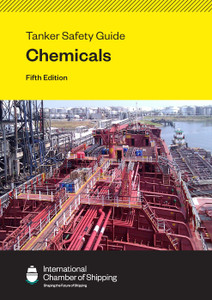
This publication provides an overview of the hoses used in production, transportation and storage of liquid chemicals, explaining their appropriate use and safe management. Product and service hoses used for water, steam, air and nitrogen are also covered.
This publication includes important safety and operational assessments that must be considered before hoses are chosen. ISO and EN standards outline hose manufacturing specifications and context is given on inherent hazards of application. The book includes maximum working pressure tables and technical diagrams that illustrate features such as flanges and end fittings. The chapter on maintenance and inspection informs readers on condemned hose features.
The
purpose
of
this
publication
is
to
provide
an
overview
of
the
various
types
of
hoses
used
in
the
production,
transportation
and
storage
of
liquid
chemicals.
It
also
explains
their
appropriate
use
and
safe
management.
While
the
main
focus
is
on
the
hoses
used
for
the
transfer
of
chemical
products,
the
essential
and
frequently
used
range
of
service
hoses
for
water,
steam,
air
and
nitrogen
are
also
covered.
While
this
publication
may
make
short
references
to
transfer
hoses
for
oil
products,
in
no
way
does
it
set
out
to
challenge
the
industry
standards
that
exist
for
the
specialist
hoses
used
for
oil
transfers
in
the
many
different
operating
environments.
Product and service hoses form an integral part of transfer operations, and their choice and use must be based on assessments that cover appropriate use, safety and operational efficiency.
The use of hoses is only recommended where fixed rigid piping is either not suitable or is impractical for the operation taking place.
The
range
of
hoses
can
vary
from
those
that
convey
products
to
those
that
provide
standalone
services,
or
provide
services
forming
part
of
an
integrated
product
or
vapour
transfer
system.
They
can
be
installed
on
a
semi-permanent
single
or
multi-use
basis,
or
be
individual
hoses
that
are
transferred
to
the
point
of
use
and
only
connected
as
and
when
required.
Depending
on
the
product
or
service
hazards
and
the
location
and
nature
of
the
application,
the
risks
involved,
and
the
subsequent
hose
choice,
installation,
control,
use,
training
and
maintenance,
will
vary.
A
hose
management
system
with
policies
and
procedures
that
are
based
on
risk
assessments
and
operability
studies
should
be
developed
and
implemented
to
ensure
the
safe
and
effective
use
of
hoses.
Operational
characteristics,
including
the
degree
of
automation
and
type
of
manual
tasks
conducted,
will
impact
on
the
policies
and
procedures
that
need
to
be
developed
and
implemented.
To ensure safe and efficient use, procedures need to be implemented for the proper cleaning, inspection, testing and maintenance of the hoses and end fittings. The procedures should include the associated handling and monitoring equipment, such as lifting and support equipment and temperature and pressure gauges.
Product
and
service
hoses
may
be
supplied
and/or
used
by
external
parties
such
as
road,
rail
or
ship
carriers,
cleaning
contractors
or
other
parties.
Appropriate
procedures,
operational
agreements
and
controls
should
be
in
place
to
ensure
that
hoses
supplied
by
external
parties
meet
the
same
standards
as
those
set
by
the
hose
management
system.
All personnel involved in purchasing, handling, cleaning, testing and maintaining hoses must be suitably trained and experienced in the use of hoses, the risks involved and the controls required.
1. Introduction
1.1 Purpose and Scope
1.2 General Introduction
2. Risk Management
2.1 Pressure Systems
2.2 Product Hoses
2.3 Product Hazards
2.4 Ancillary Hoses
2.5 Service Hoses
2.6 Third Party Hoses
3. Hose Selection
3.1 Standards, Specifications and Regulatory Requirements
3.2
General
Specifications
3.3
Hose
Supplier
and
Quality
Assurance
3.4 Environmental Conditions
3.5 Operational Conditions
4. Product Hoses
4.1 Rubber Hoses
4.2 Composite Hoses
4.3 Stainless Steel Hoses
4.4 Spiral Wound PVC Hoses
4.5 Fire Safe Hoses
4.6 Cryogenic Hoses
4.7 Product Hose End Fittings and Gaskets
5. Service Hoses
5.1 Air Hoses
5.2 Water Hoses
5.3 Steam Hoses
5.4 Nitrogen Hoses
5.5 Service Hose Couplings
6. Purchasing and Receiving Hoses
6.1 Receiving New Hoses
6.2 Marking New Hoses
6.3 Hose Records
7. Product Transfer Operations
7.1 Hose Handling
7.2 Hose Lifting Equipment
7.3 Connecting and Use
7.4 Operational Checks
8. Product Hose Cleaning and Storage
8.1 Disconnection and Transport
8.2 Cleaning Facilities and Equipment
8.3 Types of Cleaning
8.4 Waste
8.5 Hose Storage
9. Hose Inspecting, Testing and Maintenance
9.1 Regulatory Requirements and Standards
9.2 Hose Marking and Registers
9.3 Scheduled Maintenance Checks
9.4 Taking Hoses Out of Service
9.5 Repairing Hoses
9.6 Third Party Hose Testing
9.7 Increasing the Safety Factor
10. Emergency Response
CDI
The
CDI
is
a
chemical
industry
organization,
incorporated
under
the
law
of
the
Netherlands
as
the
Stichting
Chemical
Distribution
Institute
(CDI)
and
operates
as
a
non-profit
making
foundation.
CDI
is
managed
by
a
Board
of
Directors
consisting
of
seven
individuals
nominated
by
the
participating
chemical
companies.
The
Board
of
Directors
establishes
policy
and
is
responsible
for
overall
affairs
of
the
foundation.
Individual
Executive
Boards
are
elected
to
oversee
and
direct
the
staff
managing
day
to
day
activities
for
the
Marine,
Terminals
and
Marine
Packed
Cargo
Schemes.
- Number of Pages:
- 76
- ISBN:
- 9781856096638
- Binding Format:
- Hardback
- Book Height:
- 300 mm
- Book Width:
- 215 mm
- Weight:
- 0.8 kg
- Author:
CDI
- Published Date:
- September 2014
- Preview:
- Yes
- Publication Date:
- September 2014




